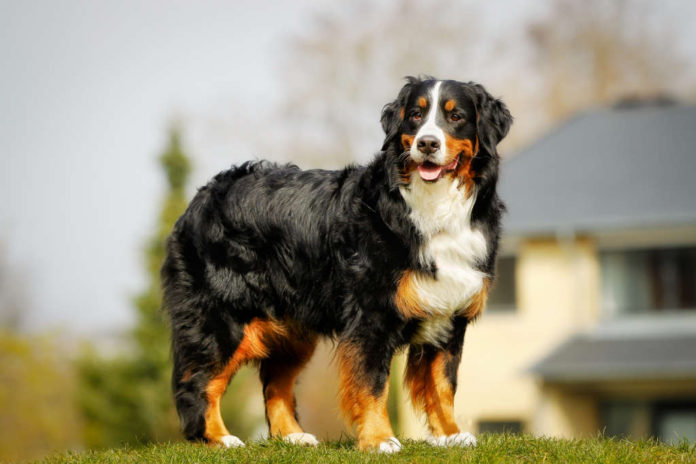Last Updated on January 18, 2024 by Fumipets
While many of us are familiar with varieties like the Saint Bernard and have probably met a Bernese Mountain Dog or two, there are more breeds that fall under the category of mountain dogs.
These canines were developed specifically to live or work in mountainous regions across the globe. Due to this, dogs now often have the ability to tolerate harsh weather, adapt to difficult terrain, and love spending time outside just as much as they do indoors.
Here are ten breeds of mountain dogs. They are all towering representations of strong canines, some of them giants, that make wonderful companion animals for the appropriate owners.
The 10 Mountain Dog Breeds
1. Saint Bernard
The Saint Bernard, which is named after the St. Bernard Hospice in Switzerland, is possibly the most well-known of these animals. Since the 17th century, monks in this area have nurtured the enormous breed, which they have employed to search the area for unfortunate and lost tourists.
The breed needs a lot of space, both inside and out, and frequent exercise. To be clear, this does not necessarily have to be long distance running, but rather a brisk stroll.
The Saint Bernard is a wonderful family companion since it has a keen awareness of its size and will guard the younger members of the family.

2. Great Pyrenees
Although not often as large as the Saint Bernard, the Great Pyrenees is another gigantic breed. In the Pyrenees mountains, the Pyr, as it is popularly known, tends after families and herds.
The breed is renowned for its capacity to identify and assess possible threats. The Great Pyrenees is thought to be a peaceful and level-headed dog, but because of its size, you will undoubtedly notice it if you bring one into your life. Given that it is a huge dog, it is another large breed that is seen as being nice to kids, but it will need a lot of room to feel comfortable.

3. Bernese Mountain Dog
A Bernese Mountain Dog has a tricolor coat that is made up of white, brown, and black, and weighs around the same as a Great Pyrenees. Along with the Appenzeller Sennenhund, the Entlebucher Mountain Dog, and the Greater Swiss Mountain Dog, it is one of four well-known and closely related Swiss mountain dogs.
Despite being smaller than the time’s gigantic breeds, this breed may be traced back to the Roman Mastiffs. It is a sturdy, healthy dog that was formerly employed for herding sheep and can withstand very cold temperatures and severe weather.

4. Newfoundland
The Newfoundland, or Newfie, is a huge breed that originated in Newfoundland and is known as a nanny dog because of how gentle they are with young children.
This enormous stuffed animal was formerly a working dog. Initially, it would have assisted in managing catches and dragging in nets like a seaman’s dog. He then evolved into a water rescue dog, and his impact grew across Switzerland’s Alps.
The breed is still often used as a rescue dog, but it’s also just as likely to be seen playing in the backyard with the kids of a family.

5. Entlebucher Mountain Dog
The smallest and quickest of the Alpen breeds is the Entlebucher Mountain Dog, another mountain dog from Switzerland. It was employed to maintain and protect livestock, and it was required to move quickly in order to follow every animal in the herd.
This independent and clever breed will appreciate some alone time, but it also enjoys spending time with you and the rest of its family since it is a loyal and faithful dog. They interact well with kids and play with them, but they need a lot of activity to have happy lives.

6. Appenzeller Sennenhund
The last of these four Swiss alpine breeds is the Appenzeller Sennenhund. It was developed to draw large carts and herd cattle, therefore its initial usage was as a draught animal.
The breed requires regular training beginning at a young age and requires a lot of activity. With a breed of size and power, it may also be quite suspicious of strangers. The Appenzeller is advised to be handled and owned by knowledgeable people.

7. Greater Swiss Mountain Dog
The biggest of the Swiss breeds is the Greater Swiss Mountain Dog, a huge dog that is often only a bit bigger than the Saint Bernard.
It was brought up as an industrious farm dog and has the same brown, white, and black markings as the other Swiss mountain breeds. It would herd cattle, pull heavy carts, and defend property.

8. Tibetan Mastiff
The breed of Tibetan Mastiff is quite old. It is an extremely resilient and strong animal since it was developed to thrive in the Himalayan highlands. Because it was bred to protect livestock, the breed is mostly nocturnal now.
The Tibetan Mastiff dislikes meeting new people. Because it is a mountain breed and was bred as a guard dog, it needs a lot of room to wander in order to be completely happy. Although they may become terrific family dogs, they benefit from early socialization and training and perform best when cared for by knowledgeable owners.

9. Leonberger
The German mountain dog breed known as the Leonberger is used in a variety of circumstances, including agricultural labor and search and rescue operations.
Although not wholly unique, the breed’s webbed feet are distinctive and demonstrate how adept this species is at swimming. It is also regarded as a gentle giant that will grow up to be a devoted family member that gets along with both kids and adults.
10. Kuvasz
A sizable breed from Siberia’s Ural area is the Kuvasz. It is currently recognized as a Hungarian breed that has historically been used to defend humans and cattle from predators.
It gets along well with kids who know how to treat dogs with respect, but because of its intense loyalty, it needs early socialization to avoid any potential issues in the future. The dog is not advised for inexperienced or new owners.

Mountain Dog Breeds
The huge to enormous mountain dog breeds mentioned above need early socialization and training to make sure that their size doesn’t become an issue.
While the majority are kind and kind by nature, they do need to pick up etiquette since they may weigh 150 pounds. Before you contemplate any of the more difficult breeds, think about your prior experience with dog ownership, particularly with big breeds.


















